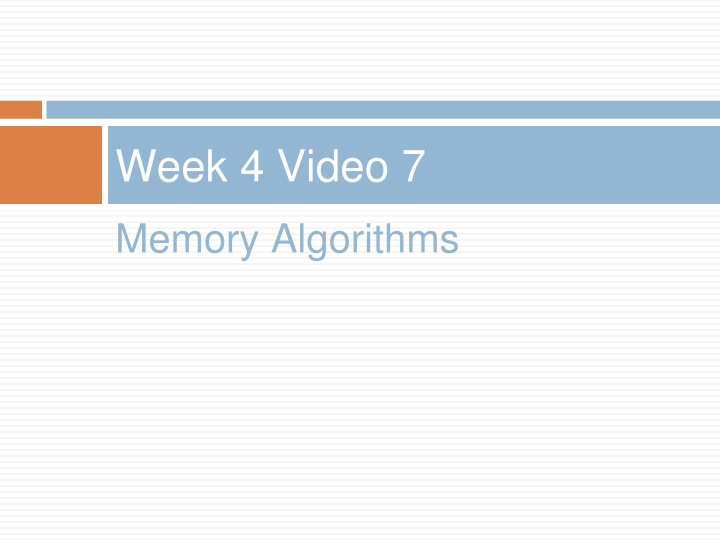
Memory Algorithms for Effective Learning
Dive into the world of memory algorithms and their impact on knowledge retention. Explore concepts like the spacing effect, ACT-R memory equations, and implications for better memory recall. Discover how optimizing learning practices can enhance memory duration and strength.
Download Presentation

Please find below an Image/Link to download the presentation.
The content on the website is provided AS IS for your information and personal use only. It may not be sold, licensed, or shared on other websites without obtaining consent from the author. If you encounter any issues during the download, it is possible that the publisher has removed the file from their server.
You are allowed to download the files provided on this website for personal or commercial use, subject to the condition that they are used lawfully. All files are the property of their respective owners.
The content on the website is provided AS IS for your information and personal use only. It may not be sold, licensed, or shared on other websites without obtaining consent from the author.
E N D
Presentation Transcript
Week 4 Video 7 Memory Algorithms
Is future correctness enough? Up until this point we ve been talking about predicting future correctness
But what if you forget it tomorrow? Another way to look at knowledge is how long will you remember it?
Relevant for all knowledge Mostly studied in the context of memory for facts, rather than skills How do you say banana in Spanish? What is the capital of New York? Where are the Islands of Langerhans?
Spacing Effect It has long been known that spaced practice (i.e. pausing between studying the same fact) is better than massed practice (i.e. cramming) Early adaptive systems implemented this behavior in simple ways (i.e. Leitner, 1972)
ACT-R Memory Equations (Pavlik & Anderson, 2005) Memory duration can be understood in terms of memory strength (referred to as activation)
ACT-R Memory Equations (Pavlik & Anderson, 2005) Formula for probability of remembering 1 ? ? ? ? ? = 1+? Where m = activation strength of current fact = threshold parameter for how hard it is to remember s is noise parameter for how sensitive memory is to changes in activation Note logistic function (like PFA)
ACT-R Memory Equations (Pavlik & Anderson, 2005) Formula for activation ? ?? ? ???1 ? = ln ?=1 We have a sequence of n cases where the learner encountered the fact Each ??represents how long ago the learner encountered the fact for the i-th time The decay parameter d represents the speed of forgetting under exponential decay
ACT-R Memory Equations (Pavlik & Anderson, 2005) Implications More practice = better memory More time between practices = better memory Most efficient learning comes from dense practice followed by expanding amounts of time in between practices (Pavlik & Anderson, 2008)
MCM (Mozer et al., 2009) Postulates that decay speed drops, the more times a fact is encountered Functionally complex model where Knowledge strength (and therefore probability of remembering) is a function of the sum of the traces actual contributions, divided by the product of their potential contributions Power function is estimated as a combination of exponential functions
DASH (Mozer & Lindsay, 2016) DASH Extends previous approaches to also include item difficulty and latent student ability Can use either MCM or ACT-R as its internal representation of how memory decays over time
Duolingo (Settles & Mercer, 2016) Fits regression model to predict both recall and estimated half-life of memory (based on lag time) Based on estimate of exponential decay of memory
Duolingo (Settles & Mercer, 2016) Uses feature set including Time since word last seen Total number of times student has seen the word Total number of times student has correctly recalled the word Total number of times student has failed to recalled the word Word difficulty
And of course See the work in the last lecture on integrating time into DKT-family algorithms
Next Week Relationship Mining
